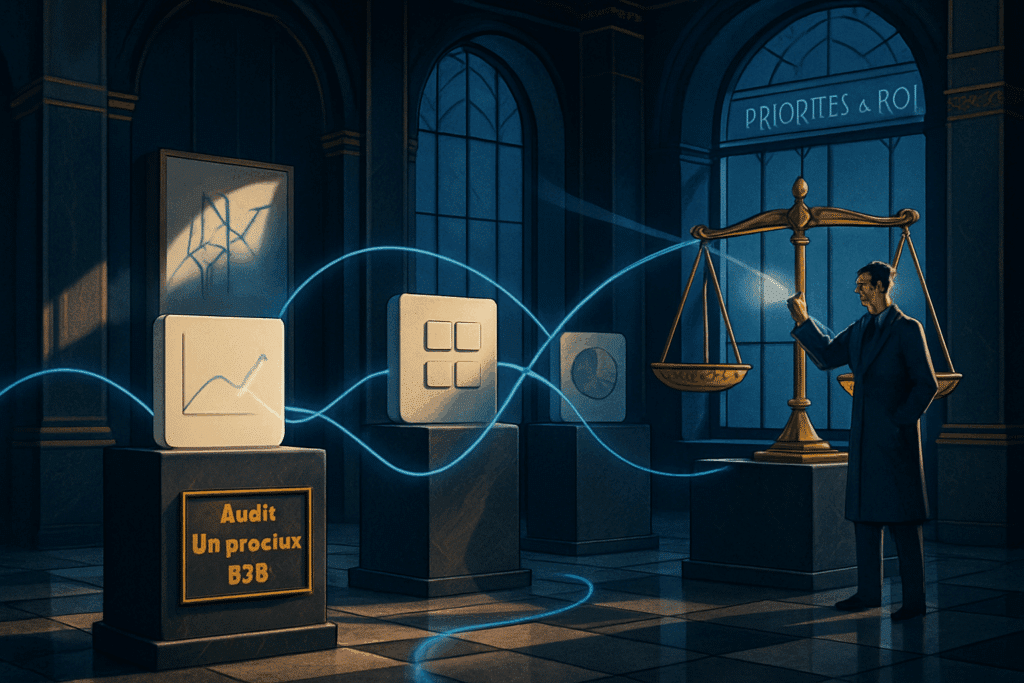Automating email marketing campaigns
Email marketing automation refers to the use of specialized software to automatically send targeted, personalized emails based on specific recipient actions. This method makes it possible to send the right message at the right time, without constant manual intervention, significantly improving customer engagement and optimizing return on investment (ROI).
- Triggers are essential for sending emails at the right moment based on user behavior.
- Different types of automated campaigns meet different needs in the customer journey.
- Segmentation and personalization enable messages to be tailored to each audience group.
- Several automation tools facilitate the creation and management of campaigns, with advanced functionalities.
- Good deliverability is crucial to ensuring that emails actually reach the inbox.
The automation of email marketing campaigns has become a must for companies wishing to optimize their digital communication efforts. By sending personalized messages triggered by specific actions, marketers achieve a higher rate of engagement than with conventional mailings. This technique exploits data collection and customer behavior to maximize conversions and ensure a better user experience. This dossier details the key concepts, current practices and tools available, as well as the benefits and steps involved in successfully implementing an effective automation strategy.
Why and when should you use email marketing automation?
Automated marketing campaigns improve the responsiveness, precision and personalization of communications. They are particularly well suited to contexts where user actions, such as registering on a site, consulting a product or making a purchase, require rapid, relevant follow-up. Automation makes it possible to deliver content tailored to each stage of the customer journey, as soon as the triggering behavior has been identified. These campaigns are aimed at companies of all sizes looking to reduce their manual workload while increasing the performance of their emailings.
Definitions and types of automated campaigns
Definition: Email automation consists of scheduling targeted mailings, based on precise conditions, using dedicated software. This optimizes the timing and relevance of the message sent.
Triggers: These are events that automatically trigger the sending of messages. They can be varied: submission of a form, clicking on a link in an e-mail, addition to a mailing list, application of a tag or even a completed purchase. This mechanism ensures that personalized emails are sent at the most appropriate moment, improving open and conversion rates[1].
Campaign types: There are many forms of automated campaigns, including :
- Onboarding campaigns: to accompany a new contact or customer from the moment they sign up.
- Automated sequences known as “drip campaigns”: series of emails sent on a programmed or conditional basis.
- Autoresponders: messages sent in response to a specific action.
- Behavioral workflows: communications triggered by observed behavior, for example after a purchase or a support request.
These types of campaigns are integrated into customer lifecycle management, enabling fluid, continuous tracking and interaction[1][13].
Segmentation and personalization
Segmentation consists of dividing the contact base into homogeneous groups according to a number of criteria: purchasing behavior, level of commitment, demographic data, customer value, etc. This division makes it easier to send targeted, relevant messages. This division makes it easier to send targeted, relevant messages.
Personalization complements segmentation by adapting email content to each segment, inserting dynamic information such as name, history-based recommendations, or specific offers. This approach increases customer engagement and the likelihood of the message prompting an action[3].
Popular automation tools
To make it easier to set up and manage automated campaigns, there is a wide range of software available on the market. Among the most widespread solutions are :
- ActiveCampaign
- Mailchimp
- Moosend
- Shopify Email
- Cognism
These tools offer visual drag-and-drop editors, simple workflow configuration, advanced segmentation options, and sometimes artificial intelligence features to optimize campaign performance[2][5][9].
The importance of deliverability
A fundamental issue in email automation is deliverability, i.e. the ability of messages to reach recipients’ inboxes rather than spam. To achieve this, a number of measures need to be taken:
- Rigorous management of IP addresses used for sending.
- Regular cleaning of contact lists to eliminate inactive or erroneous addresses.
- Configure dedicated IPs or IP pools to handle large volumes of mail.
These practices guarantee the longevity of campaigns and the effectiveness of communication[3].
Benefits of email marketing automation
Automation offers several major benefits:
- Reduce manual work by delegating message sending and tracking to the system.
- Immediate, systematic follow-up of prospects at every stage of their journey.
- Significant increase in open and click-through rates – triggered emails record up to 8 times more opens than traditional mass mailings[7].
- More personalized and relevant messages, boosting loyalty and conversions.
- Optimize return on investment through targeted, effective communication.
How do you set up an effective automation strategy?
Successful automation involves a number of structured steps:
- Choose an email marketing tool tailored to your specific needs, taking into account functionality, budget and possible integrations.
- Create and segment the contact base for better target definition.
- Define automatic scenarios based on relevant triggers to synchronize mailings.
- Write personalized emails for each step defined in workflows.
- Test campaigns, monitor performance via analytic dashboards, then continuously optimize elements to improve results[3][6].
Market context and practical applications
In a highly competitive digital environment, the automation of email marketing campaigns has become a strategic practice for companies wishing to accelerate their growth. It applies equally to e-commerce, B2B services and the non-profit sector. Automated campaigns accompany customers from brand discovery through conversion to loyalty. They also make it possible to manage customer support, post-sales follow-ups and new product promotions in a personalized and efficient way[7][12].
However, misconfiguration or over-sending can have a negative effect, notably by increasing the risk of spam or damaging the sender’s reputation. It is therefore crucial to orchestrate these campaigns rigorously and in line with best practice to guarantee a positive impact.
Summary and outlook
Automating email marketing campaigns is an essential approach to personalizing the customer experience, boosting marketing efficiency and supporting sales growth. By intelligently sending emails based on user behavior and predefined triggers, this technique maximizes customer engagement while reducing the operational burden. The choice of a suitable platform, the precise definition of segments and scenarios, and the careful monitoring of key performance indicators are all decisive factors for success. In a context of constantly evolving tools and consumer expectations, automation is an essential lever for optimizing the return on investment of marketing campaigns.
In order to deepen the automation strategy for email marketing campaigns, the analysis of new artificial intelligence functionalities integrated into current tools represents a promising avenue to follow in order to improve sending performance and customer relations.
To begin exploiting the full benefits of email automation, we recommend selecting a suitable tool, establishing clear scenarios, then launching pilot campaigns and rigorously measuring their results. This methodical approach will enable you to continuously optimize your strategy and achieve your business objectives.









